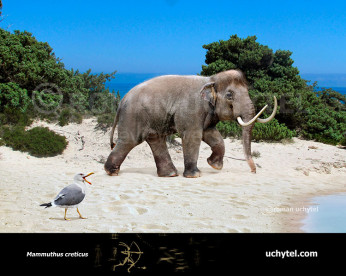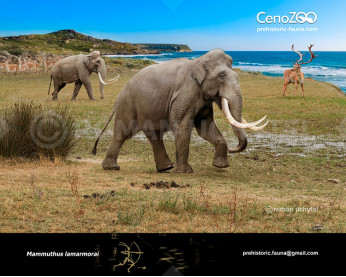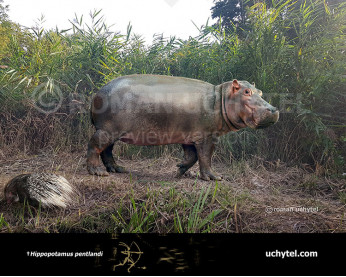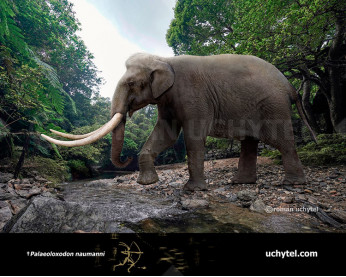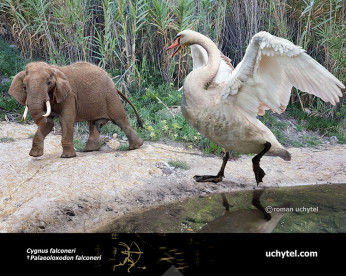Sicilian dwarf elephant
459459
Sicilian dwarf elephant ((†Palaeoloxodon mnaidriensis (Adams, 1874))
Siculo-Maltese species
Order: Proboscidea
Family: Elephantidae
Genus: †Palaeoloxodon
Dimensions: length - 2,7 m (with tusks), height - 120 -180 cm, weight - 600 - 1100 kg
Temporal range: late Middle-Late Pleistocene (Malta and Sicily, 0.2–0.02 Ma).
Palaeoloxodon mnaidriensis, also known as the Sicilian dwarf elephant , is an extinct Siculo-Maltese species of elephant that was derived from the straight-tusked elephant.
This island-bound elephant was an example of insular dwarfism, with an adult male specimen measured 150-180 cm in shoulder height and weighed about 1000 kg, and an adult female specimen measured 140 cm in shoulder height and weighed about 700 kg. P. mnaidriensis ancestors most likely reached the Mediterranean islands during a period of Pleistocene maximum when the sea levels were around 100 m lower, that significantly reduced distances and opened land bridges in between islands and from and to the mainland.
The remains from Sicily belonging a separate species, provisionally referred to as P. cf. mnaidriensis, descended from a colonisation by the straight-tusked elephant (Palaeoloxodon antiquus) during the late Middle Pleistocene, around 200,000 years ago, which replaced the even smaller one-metre-tall Palaeoloxodon falconeri, which had descended from a separate colonisation of Sicily by P. antiquus several hundred thousand years prior. The elephant species native to Malta and Sicily had reduced in body size as a result of insular dwarfism, a common phenomenon resulting from the colonisation of islands by large mammals. The much smaller body size of P. mnaidriensis compared to P. antiquus, in combination with the relatively short period of time between colonisation and small body size suggests that the rate of dwarfism was relatively rapid.
The belief in cyclopes may have originated in P. falconeri/P. mnaidriensis skulls found in Sicily. As early as the 14th century, scholars had noted that the nasal cavity could be mistaken for a singular giant eye socket.
Sicilian dwarf elephant ((†Palaeoloxodon falconeri (Busk, 1867))
Order: Proboscidea
Family: Elephantidae
Genus: †Palaeoloxodon
Dimensions: length - 2,3 m (with tusks), height - 90-100 cm, weight - 200 - 320 kg
Temporal range: late Middle Pleistocene (Malta and Sicily, around 500–200,000 years ago)
Palaeoloxodon falconeri is an extinct species of dwarf elephant from the Middle Pleistocene of Sicily and Malta. A member of the genus Palaeoloxodon, it derived from a population of the mainland European straight-tusked elephant (Palaeoloxodon antiquus), which arrived in Europe approximately 800,000 years ago.
This island-bound elephant is considered to be an example of insular dwarfism, with adult individuals around the size of modern elephant calves.
P. falconeri's ancestors most likely reached Sicily from the Italian mainland, likely via a series of islands that now form part of the southern Calabrian peninsula. The chronology of the species compared to that of the larger endemic species of Palaeoloxodon on Malta and Sicily, the 180 cm tall Palaeoloxodon mnaidriensis, is somewhat uncertain. It is generally thought that P. falconeri is the earlier species dating to the Middle Pleistocene, and that P. mnaidriensis descends from a subsequent separate late Middle Pleistocene colonisation of the island by P. antiquus, suggested to date to approximately 200,000 years ago.
Sicilian dwarf elephant became extinct on Sicily around 200,000 years ago, due to the uplifting of northeast Sicily and Calabria resulting in a narrowing of the distance between the island and the Italian mainland, similar to the geography in the region today, allowing a number of large mammal species from mainland Italy to colonise the island, including carnivores like cave hyenas, cave lions, grey wolves, brown bears, and red foxes, and herbivores like wild boar, red deer, fallow deer, aurochs, steppe bison and the hippo Hippopotamus pentlandi. The straight-tusked elephant again recolonised the island during this episode, giving rise to Palaeoloxodon mnaidriensis, which though strongly dwarfed, was considerably larger than P. falconeri, with its larger body size likely a reaction to these large predators and competitors.
Payment
You may use multiple payment methods to buy image such as credit cards, PayPal and bank transfer.
Sicilian dwarf elephant ((†Palaeoloxodon mnaidriensis (Adams, 1874))
Siculo-Maltese species
Order: Proboscidea
Family: Elephantidae
Genus: †Palaeoloxodon
Dimensions: length - 2,7 m (with tusks), height - 120 -180 cm, weight - 600 - 1100 kg
Temporal range: late Middle-Late Pleistocene (Malta and Sicily, 0.2–0.02 Ma).
Palaeoloxodon mnaidriensis, also known as the Sicilian dwarf elephant , is an extinct Siculo-Maltese species of elephant that was derived from the straight-tusked elephant.
This island-bound elephant was an example of insular dwarfism, with an adult male specimen measured 150-180 cm in shoulder height and weighed about 1000 kg, and an adult female specimen measured 140 cm in shoulder height and weighed about 700 kg. P. mnaidriensis ancestors most likely reached the Mediterranean islands during a period of Pleistocene maximum when the sea levels were around 100 m lower, that significantly reduced distances and opened land bridges in between islands and from and to the mainland.
The remains from Sicily belonging a separate species, provisionally referred to as P. cf. mnaidriensis, descended from a colonisation by the straight-tusked elephant (Palaeoloxodon antiquus) during the late Middle Pleistocene, around 200,000 years ago, which replaced the even smaller one-metre-tall Palaeoloxodon falconeri, which had descended from a separate colonisation of Sicily by P. antiquus several hundred thousand years prior. The elephant species native to Malta and Sicily had reduced in body size as a result of insular dwarfism, a common phenomenon resulting from the colonisation of islands by large mammals. The much smaller body size of P. mnaidriensis compared to P. antiquus, in combination with the relatively short period of time between colonisation and small body size suggests that the rate of dwarfism was relatively rapid.
The belief in cyclopes may have originated in P. falconeri/P. mnaidriensis skulls found in Sicily. As early as the 14th century, scholars had noted that the nasal cavity could be mistaken for a singular giant eye socket.
Sicilian dwarf elephant ((†Palaeoloxodon falconeri (Busk, 1867))
Order: Proboscidea
Family: Elephantidae
Genus: †Palaeoloxodon
Dimensions: length - 2,3 m (with tusks), height - 90-100 cm, weight - 200 - 320 kg
Temporal range: late Middle Pleistocene (Malta and Sicily, around 500–200,000 years ago)
Palaeoloxodon falconeri is an extinct species of dwarf elephant from the Middle Pleistocene of Sicily and Malta. A member of the genus Palaeoloxodon, it derived from a population of the mainland European straight-tusked elephant (Palaeoloxodon antiquus), which arrived in Europe approximately 800,000 years ago.
This island-bound elephant is considered to be an example of insular dwarfism, with adult individuals around the size of modern elephant calves.
P. falconeri's ancestors most likely reached Sicily from the Italian mainland, likely via a series of islands that now form part of the southern Calabrian peninsula. The chronology of the species compared to that of the larger endemic species of Palaeoloxodon on Malta and Sicily, the 180 cm tall Palaeoloxodon mnaidriensis, is somewhat uncertain. It is generally thought that P. falconeri is the earlier species dating to the Middle Pleistocene, and that P. mnaidriensis descends from a subsequent separate late Middle Pleistocene colonisation of the island by P. antiquus, suggested to date to approximately 200,000 years ago.
Sicilian dwarf elephant became extinct on Sicily around 200,000 years ago, due to the uplifting of northeast Sicily and Calabria resulting in a narrowing of the distance between the island and the Italian mainland, similar to the geography in the region today, allowing a number of large mammal species from mainland Italy to colonise the island, including carnivores like cave hyenas, cave lions, grey wolves, brown bears, and red foxes, and herbivores like wild boar, red deer, fallow deer, aurochs, steppe bison and the hippo Hippopotamus pentlandi. The straight-tusked elephant again recolonised the island during this episode, giving rise to Palaeoloxodon mnaidriensis, which though strongly dwarfed, was considerably larger than P. falconeri, with its larger body size likely a reaction to these large predators and competitors.

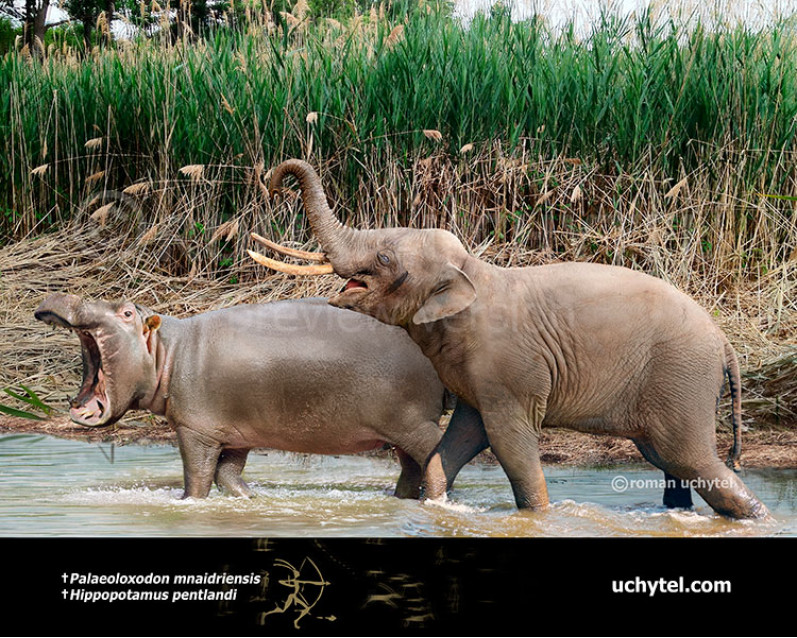
-797x638.jpg)
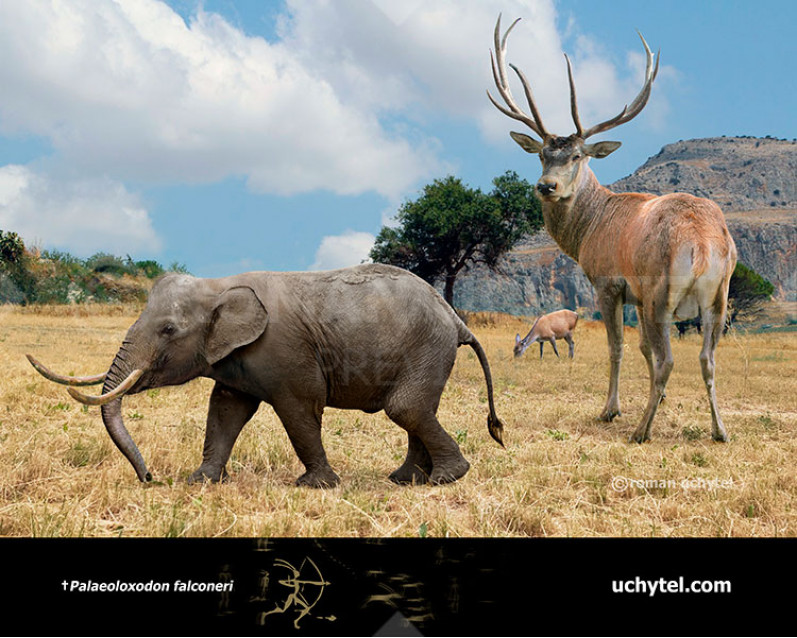
1-797x638.jpg)
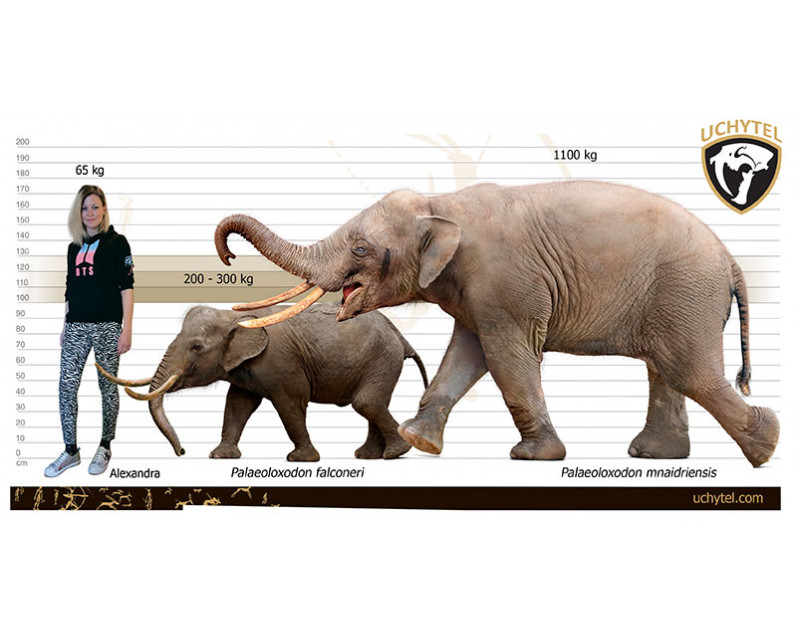

-70x56.jpg)

1-70x56.jpg)

-346x277.jpg)
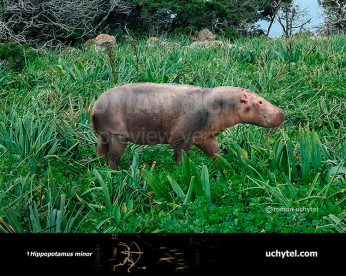
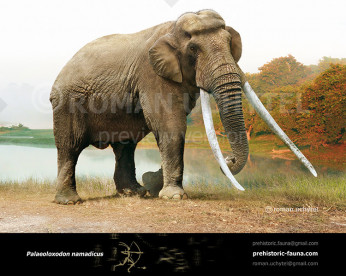
-cypriotes-346x277.jpg)
